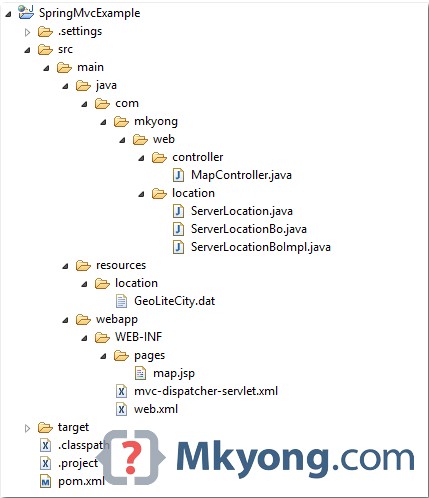在本文中,读者将学习到如何使用Spring MVC框架和jQuery及Google Map,制作一个简单的根据IP位置查找应用。用户可以在页面中输入一个IP地址,然后通过Google Map显示该IP所在的大概地理位置(注:本文使用的数据库是GeoLite)。本教程完成后,其效果图如下:
在本教程中,用户将用到如下技术:
Spring MVC frameworks
jQuery(Ajax Request)
GeoLite 数据库
Google Map
其中用户的操作步骤如下:
用户输入IP地址,然后点提交按钮
jQuery发出Ajax请求到Spring MVC中的控制器
在Spring MVC控制器中处理并返回JSON格式数据
jQuery处理返回的json数据并通过Google Map展示给用户
1 项目结构
项目结构如下图,使用的是MAVEN工程
这里,我们要下载专门的地理数据库GeoLite,其中我们下载的是GeoLite格式的IP数据库,地址如下: http://dev.maxmind.com/geoip/legacy/geolite/,并放置在resource文件夹下。
2 MAVEN包依赖
在本项目的pom.xml中,加入如下的包依赖,如下:
//...
<properties>
<spring.version>3.2.2.RELEASE</spring.version>
<maxmind.geoip.version>1.2.10</maxmind.geoip.version>
<jackson.version>1.9.10</jackson.version>
</properties>
<dependencies>
<!-- Spring Core -->
<dependency>
<groupId>org.springframework</groupId>
<artifactId>spring-core</artifactId>
<version>${spring.version}</version>
</dependency>
<!-- need this for @Configuration -->
<dependency>
<groupId>cglib</groupId>
<artifactId>cglib</artifactId>
<version>2.2.2</version>
</dependency>
<dependency>
<groupId>org.springframework</groupId>
<artifactId>spring-web</artifactId>
<version>${spring.version}</version>
</dependency>
<dependency>
<groupId>org.springframework</groupId>
<artifactId>spring-webmvc</artifactId>
<version>${spring.version}</version>
</dependency>
<!-- ip to server location -->
<dependency>
<groupId>com.maxmind.geoip</groupId>
<artifactId>geoip-api</artifactId>
<version>${maxmind.geoip.version}</version>
</dependency>
<!-- Jackson -->
<dependency>
<groupId>org.codehaus.jackson</groupId>
<artifactId>jackson-mapper-asl</artifactId>
<version>${jackson.version}</version>
</dependency>
</dependencies>
//...
3 Spring MVC+Geo Lite
下面首先编写根据IP查找地理位置的接口,命名为ServerLocationBo.java,代码为:
package com.mkyong.web.location;
ublic interface ServerLocationBo {
ServerLocation getLocation(String ipAddress);
其实现类的代码为:
package com.mkyong.web.location;
import java.io.IOException;
import java.net.URL;
import org.springframework.stereotype.Component;
import com.maxmind.geoip.Location;
import com.maxmind.geoip.LookupService;
import com.maxmind.geoip.regionName;
@Component
public class ServerLocationBoImpl implements ServerLocationBo {
@Override
public ServerLocation getLocation(String ipAddress) {
String dataFile = "location/GeoLiteCity.dat";
return getLocation(ipAddress, dataFile);
}
private ServerLocation getLocation(String ipAddress, String locationDataFile) {
ServerLocation serverLocation = null;
URL url = getClass().getClassLoader().getResource(locationDataFile);
if (url == null) {
System.err.println("location database is not found - "
+ locationDataFile);
} else {
try {
serverLocation = new ServerLocation();
LookupService lookup = new LookupService(url.getPath(),
LookupService.GEOIP_MEMORY_CACHE);
Location locationServices = lookup.getLocation(ipAddress);
serverLocation.setCountryCode(locationServices.countryCode);
serverLocation.setCountryName(locationServices.countryName);
serverLocation.setRegion(locationServices.region);
serverLocation.setRegionName(regionName.regionNameByCode(
locationServices.countryCode, locationServices.region));
serverLocation.setCity(locationServices.city);
serverLocation.setPostalCode(locationServices.postalCode);
serverLocation.setLatitude(
String.valueOf(locationServices.latitude));
serverLocation.setLongitude(
String.valueOf(locationServices.longitude));
} catch (IOException e) {
System.err.println(e.getMessage());
}
}
return serverLocation;
}
}
在上面的这个方法中,在getLocations方法中,加载了GeoLite格式的IP地址库文件GeoLiteCity.dat,并且调用getLocation方法进行IP的查找,.在getLocation方法中,通过GeoLite创建一个LookupService类的实例,其中传入要查询的IP地址库文件,然后再调用其getLocation方法进行查询,这里查询出来的结果构造成serverLocation对象,下面来看下其serverlocation对象的代码:
package com.mkyong.web.location;
public class ServerLocation {
private String countryCode;
private String countryName;
private String region;
private String regionName;
private String city;
private String postalCode;
private String latitude;
private String longitude;
//getter and setter methods
}
然后我们使用Spring MVC框架中的Jackson对结果进行转换,转换为json,代码如下:
package com.mkyong.web.controller;
import org.codehaus.jackson.map.ObjectMapper;
import org.springframework.beans.factory.annotation.Autowired;
import org.springframework.stereotype.Controller;
import org.springframework.web.bind.annotation.RequestMapping;
import org.springframework.web.bind.annotation.RequestMethod;
import org.springframework.web.bind.annotation.RequestParam;
import org.springframework.web.bind.annotation.ResponseBody;
import org.springframework.web.servlet.ModelAndView;
import com.mkyong.web.location.ServerLocation;
import com.mkyong.web.location.ServerLocationBo;
@Controller
public class MapController {
@Autowired
ServerLocationBo serverLocationBo;
@RequestMapping(value = "/", method = RequestMethod.GET)
public ModelAndView getPages() {
ModelAndView model = new ModelAndView("map");
return model;
}
//return back json string
@RequestMapping(value = "/getLocationByIpAddress", method = RequestMethod.GET)
public @ResponseBody
String getDomainInJsonFormat(@RequestParam String ipAddress) {
ObjectMapper mapper = new ObjectMapper();
ServerLocation location = serverLocationBo.getLocation(ipAddress);
String result = "";
try {
result = mapper.writeValueAsString(location);
} catch (Exception e) {
e.printStackTrace();
}
return result;
}
}
这对于熟悉Spring MVC的用户应该并不陌生。经过转换后的结果转换为字符串。
4 JSP+jQuery+Google Map展示最后的结果
最后我们在页面中,通过jQuery发送ajax请求调用Spring MVC控制层,然后将返回的结果展示在页面中,代码如下:
<html>
<head>
<script src="http://maps.google.com/maps/api/js?sensor=true"></script>
<script src="//ajax.googleapis.com/ajax/libs/jquery/1.10.2/jquery.min.js"></script>
</head>
<body>
<h2>Spring MVC + jQuery + Google Map</h2>
<div>
<input type="text" placeholder="0.0.0.0" id="w-input-search" value="">
<span>
<button id="w-button-search" type="button">Search</button>
</span>
</div>
<script>
$(document).ready(function() {
$("#w-button-search").click(function() {
$.getJSON("${pageContext.request.contextPath}/getLocationByIpAddress",
{
ipAddress : $('#w-input-search').val()
},
function(data) {
var data = JSON.stringify(data);
var json = JSON.parse(data);
showMap(json["latitude"],json["longitude"])
$("#result").html(data)
})
.done(function() {
})
.fail(function() {
})
.complete(function() {
});
});
var map;
function showMap(latitude,longitude) {
var googleLatandLong = new google.maps.LatLng(latitude,longitude);
var mapOptions = {
zoom: 5,
center: googleLatandLong,
mapTypeId: google.maps.MapTypeId.ROADMAP
};
var mapDiv = document.getElementById("map");
map = new google.maps.Map(mapDiv, mapOptions);
var title = "Server Location";
addMarker(map, googleLatandLong, title, "");
}
function addMarker(map, latlong, title, content) {
var markerOptions = {
position: latlong,
map: map,
title: title,
clickable: true
};
var marker = new google.maps.Marker(markerOptions);
}
});
</script>
<br/>
<div id="result"></div>
<br/>
<div style="width:600px;height:400px" id="map"></div>
</body>
</html>

